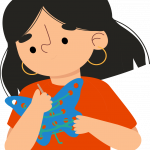How Hand Sewing is more than a Craft?
In a world increasingly dominated by screens and digital interactions, the charm and therapeutic value of traditional activities are gaining renewed appreciation. One such activity is hand sewing, a timeless craft that offers a myriad of psychological benefits. Beyond its meditative qualities, hand sewing serves as a unique bridge between generations, fostering deep and meaningful connections between young kids and their grandparents. This blog explores the psychological benefits of hand sewing and how it nurtures relationships across generations.

Hand sewing is an inherently mindful activity that requires concentration, patience, and a steady hand. Each stitch is a small, deliberate action that focuses the mind, much like the repetitive movements in practices such as knitting or crocheting. There are some psychological benefits to it. Firstly, the rhythmic motion of needle and thread can be incredibly soothing. Engaging in hand sewing allows individuals to enter a state of flow, where they become fully absorbed in the task at hand. This immersion can lead to reduced stress levels and a sense of calm, providing a welcome respite from the hustle and bustle of daily life. Secondly hand sewing demands attention to detail. Whether it’s following a pattern or ensuring stitches are even, this craft sharpens focus and concentration. This heightened state of awareness can be especially beneficial for children, helping them develop their ability to concentrate on tasks for extended periods. Finally, completing a sewing project, no matter how small, can instill a profound sense of accomplishment. For children, the tangible result of their effort—a finished piece of embroidery, a handmade doll, or a simple hand-sewn bag—can significantly boost their self-esteem. This feeling of achievement is equally rewarding for grandparents, who take pride in passing down their skills and seeing their grandchildren succeed.

The act of sewing together provides a unique opportunity for grandparents and grandchildren to connect on a deeper level. When grandparents teach their grandchildren to sew, they are not just imparting a skill they are creating lasting memories. The shared
laughter, the stories told over the sewing table, and the mutual frustration over a tricky stitch all contribute to a rich tapestry of shared experiences. These memories become cherished moments that both generations will hold dear. Hand sewing sessions often become storytelling sessions. As hands work with needle and thread, mouths often engage in sharing family stories, anecdotes, and life lessons.
This storytelling tradition is an essential part of cultural transmission, allowing grandparents to share their heritage and values with the younger generation in an engaging and informal setting. Sewing projects take time and require patience—a valuable lesson for both young and old. For children, it’s a chance to learn about perseverance and delayed gratification. For grandparents, it’s an opportunity to practice patience and understanding as they guide their grandchildren through the learning process. This mutual patience helps build respect and empathy between generations.
Hand sewing offers therapeutic benefits that extend beyond the individual to the relationship itself.
- Engaging in a creative activity together can enhance emotional connections and provide a sense of shared purpose.
- Working on a sewing project together encourages teamwork. Grandparents and grandchildren must communicate effectively, share responsibilities, and work towards a common goal. This collaboration builds a sense of unity and strengthens their bond.
- The relaxed and supportive environment of a sewing session can provide a safe space for emotional expression. Children might find it easier to open up about their feelings while their hands are busy with needles and thread. Similarly, grandparents can share their wisdom and offer guidance in a nurturing and non-confrontational way.
- Sewing projects often involve creative problem-solving. Whether it’s figuring out how to fix a mistake or deciding on the design of a project, both generations must think creatively and work together to find solutions. This collaborative problem-solving fosters creativity and strengthens cognitive skills. Hand sewing is more than just a craft; it is a bridge that connects generations, offering a unique blend of psychological benefits and relationship-building opportunities. For young kids, it’s a chance to learn a valuable skill, develop patience, and create cherished memories. For grandparents, it’s an opportunity to pass down their knowledge, bond with their grandchildren, and experience the joy of teaching.